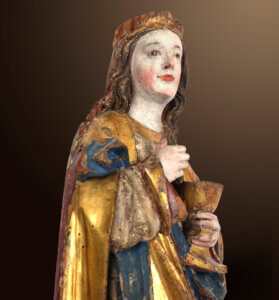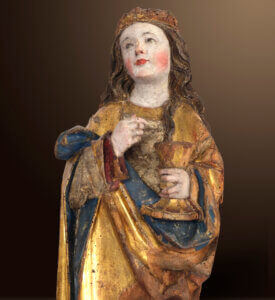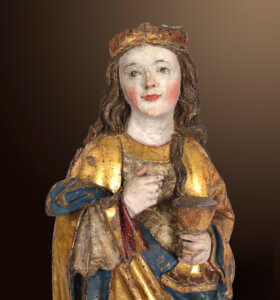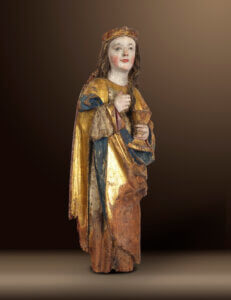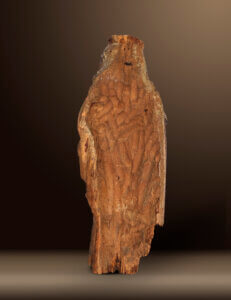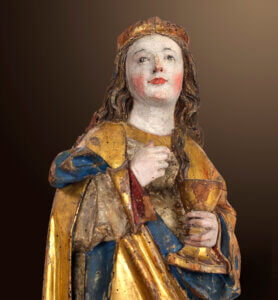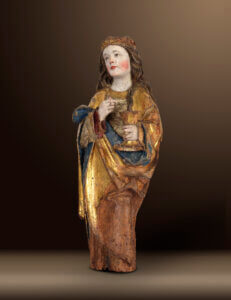St. Barbara is one of the best-known and most popular saints. Barbara of Nicomedia probably lived in the third century AD. Numerous legends, probably dating back to the 7th century, surround her life: According to one legend, for example, she was locked in a tower by her pagan father because he wanted to prevent her from getting married. Here, however, Barbara was baptized and revealed herself as a Christian. Her father finally handed her over to the Roman governor. No torture could harm her until her own father beheaded her, after which he was struck by lightning and burned to death. As one of the fourteen holy helpers, she is summoned to pray for the forgiveness of sins. In Germany, Barbara is considered one of the three Madl’n, together with Katharina and Margarete. She is also the patron saint of mining and miners, but also of architects and goldsmiths.
In this half relief, St. Barbara is depicted standing, her gaze directed upwards. A crown ring sits on her head above long, wavy hair. She is holding a chalice in her left hand and has brought her right hand to her chest. The long, luxurious coat with a golden exterior and blue lining is tucked into the crook of her right arm. The polychromy is particularly well preserved in the incarnation of the face. Her oval face shows short eyebrows, large and wide open round eyes, a small nose and full red lips. Her cheeks are flushed with youthful freshness, her short chin is also emphasized. Her enraptured gaze into the distance could indicate a conversation with the Lord.
The relief is stylistically related to that of St. Barbara in the winged altar of the parish church of Dambel, Nonsberg, from 1520. The altar is probably an import from southern Germany, possibly from the vicinity of Memmingen. The angular V-shaped folds under the protruding bowl crease and the sloping face with a long neck are comparable. There are also similarities to workshop works by Daniel Mauch (Ulm c. 1477 – 1540 Liège). As the last great artist of the Ulm School, Mauch is of particular importance. He opened his own workshop in 1503 and worked on numerous late Gothic altarpiece projects. His works already show echoes of the transition from the late Gothic to the Renaissance. For example, a half-relief of St. Sebastian shows parallels in the posture of the head, the sharp-edged drapery and the fold over the crook of the arm (Liebighaus, Frankfurt am Main, inv. no. 1374). The style of the carved curls and the lovely expression on the saint’s face also show similarities to the sculptures by Niklaus Weckmann (active in Ulm around 1481-1526). The stylistic classification in the Swabian region is therefore clear. The sculpture also has an extremely exciting provenance: according to an old auction label on the back, it comes from the Borghese collection (“Vente Borghese”).
Literature:
Barbara Maier-Lörcher, Masterpieces of Ulm Art, Ostfildern 2004.
Brigitte Reinhardt (ed.), Michel Erhart & Jörg Syrlin the Elder: Late Gothic in Ulm, Ulm 2002.
Susanne Wagini, Der Ulmer Bildschnitzer Daniel Mauch (1477-1540), Forschungen zur Geschichte der Stadt Ulm (Volume 24), Ulm 1995.
LINKS:
https://commons.wikimedia.org/wiki/Category:Daniel_Mauch?uselang=de#/media/File:Daniel_Mauch_(Werkstatt)_Hl_Sebastian_Liebieghaus_1374.jpg https://commons.wikimedia.org/wiki/File:Niklaus_Weckmann_%28Werkstatt%29_Anbetung_der_Hirten_1523-24-2.jpg
